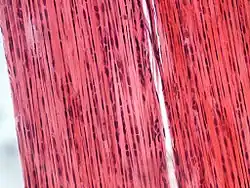Dense connective tissue
| Dense connective tissue | |
|---|---|
 | |
| Details | |
| Identifiers | |
| Latin | textus connectivus compactus |
| TH | H2.00.03.1.00003 |
| Anatomical terms of microanatomy | |
Dense connective tissue, also called dense fibrous tissue, is a type of connective tissue with fibers as its main matrix element.[1] The fibers are mainly composed of type I collagen. Crowded between the collagen fibers are rows of fibroblasts, fiber-forming cells, that generate the fibers. Dense connective tissue forms strong, rope-like structures such as tendons and ligaments. Tendons attach skeletal muscles to bones; ligaments connect bones to bones at joints. Ligaments are more stretchy and contain more elastic fibers than tendons. Dense connective tissue also make up the lower layers of the skin (dermis), where it is arranged in sheets.[2]
Classification
It is classified as either dense regular connective tissue or dense irregular connective tissue.[3]
See also
References
- ↑ "Blue Histology". Retrieved 2009-10-16.
- ↑ Marieb, Elaine N. (2009). Essentials of Human Anatomy and Physiology - 10th ed. San Francisco, Ca.: Pearson Education. p. 96. ISBN 978-0-321-69598-7.
- ↑ Strum, Judy M.; Gartner, Leslie P.; Hiatt, James L. (2007). Cell biology and Histology. Hagerstwon, MD: Lippincott Williams & Wilkins. p. 83. ISBN 978-0-7817-8577-8.
External links
- Anatomy photo: TermsCells&Tissues/connective/dense/dense1 - Comparative Organology at University of California, Davis - "Connective tissue, dense (LM, Low)"
- Histology at cytochemistry.net
- Overview at downstate.edu